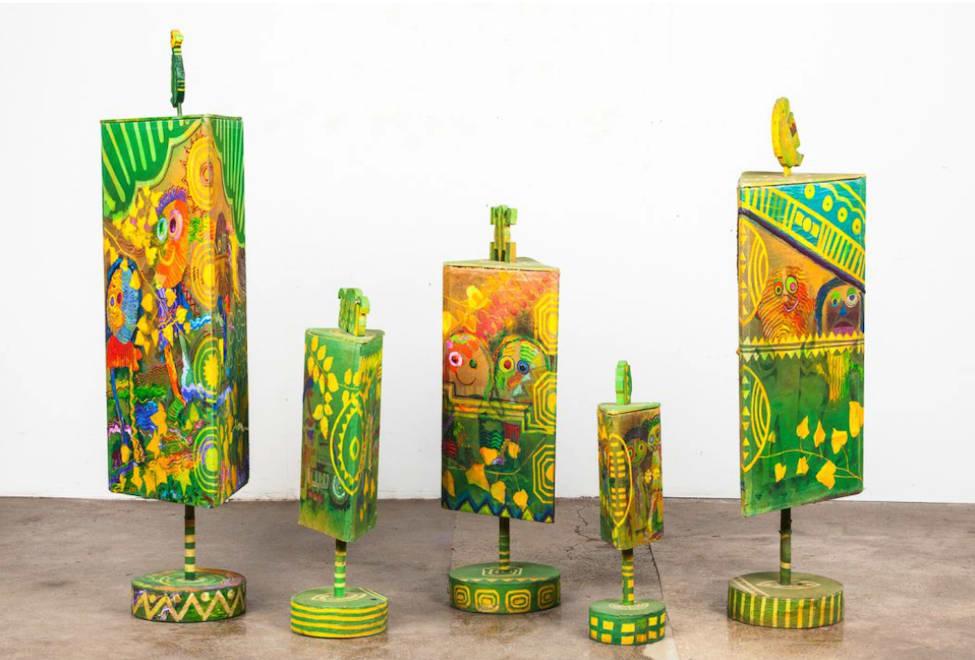
On view at 219 N. Elizabeth St., Chicago, IL 60607
Kavi Gupta is proud to present Come Saturday Punch, a career survey of the art of Wadsworth Jarrell (b. 1929, USA).
Jarrell’s work is a pivotal element of two major international exhibitions this summer: Soul of a Nation: Art in the Age of Black Power, currently on view at The Broad in Los Angeles, and AFRICOBRA: Nation Time, an official collateral exhibition of the 2019 Venice Biennale.
In 1968, Jarrell came to prominence as one of the five co-founders of AFRICOBRA (African Commune of Bad Relevant Artists), a Black artist collective formed on the South Side of Chicago, which helped define the visual language of the Black Arts Movement of the 60s and 70s.
Yet, for decades prior, Jarrell had already been experimenting with his aesthetic voice, transitioning gradually from the illustrative figuration of paintings like Come Saturday(1959), to the Orphic Cubist-inspired, abstract dynamism of Cockfight (1965). Jarrell was a mature painter when he contributed to the development of the AFRICOBRA aesthetic. The group’s embrace of “cool-ade” colors, text, and positive images of the Black community may be seen as an enlargement of Jarrell’s voice, but as we can see in paintings like Sign of the Times (1966) and Shore Market (1968), to a large degree these ideas were already emerging out of his own experiments.
Essential to Jarrell’s practice is the belief that the creation of an art object is inherently personal. Though informed by history and governed by material realities, his process always begins and ends with his own experiences. Many of the seminal works he painted at the height of the AFRICOBRA years—like Black Family (1968) and Boss Couple(1970)—directly reference Jarrell’s personal life. Even seemingly less personal works, such as I Am Better Than Those Motherfuckers and They Know It (1969) and Homage to a Giant (1970), examine the broader culture through Jarrell’s distinctly individuated point of view.
Music has also always been fundamental to Jarrell’s personal vision. Not only are musicians and their work frequently the subject matter of his paintings, but Jarrell additionally succeeds in expressing the abstract connections between music and visual art. On the occasion of the Cleveland Museum of Art’s acquisition of Jarrell’s 1973 painting Untitled (African Rhythm, Our Heritage), Heather Lemonedes, the museum’s Chief Curator, said of the painting, it “literally sings and trumpets.”
Come Saturday Punch traces all aspects of Jarrell’s artistic evolution to the present day. Works like John Coltrane (1992) and I Remember Bill (1995) reveal how he was influenced as much by his experiences with indigenous African art at FESTAC ‘77 as by the academic ethos he encountered afterwards while teaching at universities in Washington, DC, and Georgia. Also evident is the profound influence of folk art & craft on Jarrell’s methods—echoes of owning and operating resale boutiques with his wife, fashion designer and fellow AFRICOBRA member Jae Jarrell. As these various perspectives merge, Jarrell’s paintings become more layered, more sculptural, and begin incorporating found object assemblage—strategies that are on full view in works like Cuttin’ Edge Musicians (2012), Flowers for Lady (2012), and the work that closes the exhibition, Come Sunday (2014).
Fluctuating between image and object, abstraction and figuration, Jarrell’s works communicate right now, with a gentle and timeless spirit. Wadsworth Jarrell: Come Saturday Punch intimately connects to this fascinating artist’s story—and to the moments of wonder and reflection that informed his evolution into the artist he has become. Even viewers familiar with Jarrell will find much new here in which to delight.
Jarrell’s work has been exhibited in some of the most beloved institutions in the world, including the Tate Modern, the Brooklyn Museum, Crystal Bridges Museum of Art, the Studio Museum in Harlem, and many others. It is included in many important collections, including those of the Cleveland Museum of Art, the High Museum of Art, the National Museum of Africa American History and Culture, and the Studio Museum in Harlem.
Image: Spring Love, 1984. Acrylic, canvas and wood , Five total, variable sizes



